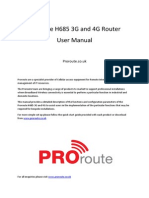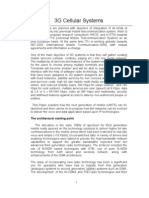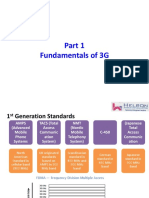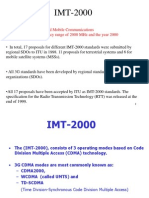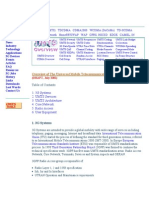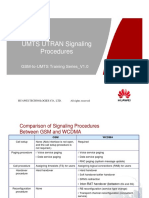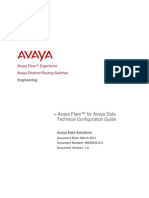UMTS Architecture
Uploaded by
Arjun AslekarUMTS Architecture
Uploaded by
Arjun AslekarWireless Cellular Network Technologies: 3G Mobile Telephony UMTS
UMTS Overview Standards System Architecture Protocol Architecture Radio Interface & Modulation Quality of Services (QoS Security
2 System rchitecture
Figure umts1 shows the system architecture of UMTS. The NSS, the OSS, and the GPRS su GSM!GPRS system constitute the "ore Networ# $"N% in the UMTS system. "N has two &ogia& domains 1. the Circuit Switched Domain (CSD) connected to PSTN '. the Packet Switched Domain (PSD) connected to a Pac#et (ata Networ# $P(N%, usua&&y an )P or an *.'+ networ#. "om onents and interfaces of the "N architecture are shown in Figure umts'. ort nodes SGSN and GGSN of the
Figure umts1. UMTS system architecture
Figure umts2. Components and interfaces of the CN architecture.
The UMTS enhancement of the ,SS in GSM!GPRS is a Radio Networ# Su-system $RNS% ca&&ed Uni.ersa& Terrestria& Radio /ccess Networ# $UTR/N%. The UTR/N architecture with e0terna& and interna& interfaces is shown in Figure umts1. Four new o en interfaces are defined2
Uu2 U3 to Node , $UTR/, the UMTS 45"(M/ air interface )u2 RN" to GSM Phase '6 "N interface $MS"!78R or SGSN% i. ii. )u9"S for circuit9switched data )u9PS for ac#et9switched data
)u-2 RN" to Node , interface
)ur2 RN" to RN" interface, not com ara-&e to any interface in GSM.
The )u, )u-, and )ur interfaces are -ased on /TM transmission rinci &es.
Figure umts3. Architecture of interfaces for UTRAN.
/ UTR/N Radio Net "ontro&&er $RN"% contro&&ing connections is ca&&ed a Ser.ing RN" $SRN"%. / RN" offering additiona& resources, for e0am &e in soft hando.er is ca&&ed a (rift RN" $(RN"%. The functions of RN" are2 o Radio Resource "ontro&
o o o o o o o o o
/dmission "ontro& "hanne& /&&ocation Power "ontro& Settings :ando.er "ontro& Macro (i.ersity "i hering Segmentation ! Reassem-&y ,roadcast Signa&&ing O en 8oo Power "ontro&
/ UTR/N Node , is the hysica& unit for radio transmission!rece tion with ce&&s. One or more ce&&s may -e ser.ed -y a Node , which a&so can -e co9&ocated with a GSM ,TS. The UMTS enhancement of the S)M in a GSM!GPRS Mo-i&e Station $MS% is the Uni.ersa& S)M $US)M% in a User 3;ui ment $U3%.
/ UMTS U3 can o erate in one of three modes of o eration. The different UMTS U3 o eration modes are defined as fo&&ows2
PS (Packet Switched) mode2 The U3!MS is attached to the PS( on&y and may on&y o erate ser.ices on the PS(. :owe.er, this does not re.ent the offering of "S9&i#e ser.ices o.er PS $e.g., .oice o.er )P%. CS (Connection Switched) mode2 The U3!MS is attached to the "S( on&y and may on&y o erate ser.ices of the "S(. :owe.er, this does not re.ent the offering of PS9&i#e ser.ices o.er "S. PS/CS mode 2 The U3!MS is attached to -oth the PS( and the "S(. The MS is ca a-&e of simu&taneous&y o erating -oth PS and "S ser.ices. /&& com-inations of different o eration modes as descri-ed for GSM and UMTS U3!MSs wi&& -e a&&owed for GSM and UMTS mu&tisystem termina&s. / GSM!3(G3 ,SS must howe.er -e modified in order to -e used as a radio access networ# to a 1G UMTS "N. Rea& time
ser.ices are not su orted in a 'G "N. The GSM!3(G3 Radio /ccess Networ# $G3R/N% standard 3TS) TS 1<1 =+1 $1GPP TS <1.=+1% s ecifies a ,SS with the a-i&ity to interface a&so with a 1G UMTS core networ# o.er the &u interface used in UTR/N, see Figure umts<. The same G3R/N can thus su ort se arate 'G and 1G "Ns, see Figure umts+
Figure umts4. Functional architecture and interfaces of a GERAN BSS.
Figure umts5. GERAN support for separate G and !G CNs
You might also like
- Proroute H685 3G and 4G Router User Guide PDFNo ratings yetProroute H685 3G and 4G Router User Guide PDF125 pages
- UMTS Protocols and Protocol Testing TutorialNo ratings yetUMTS Protocols and Protocol Testing Tutorial8 pages
- Radio Access Network Architecture: Figure 3.1. UMTS System ArchitectureNo ratings yetRadio Access Network Architecture: Figure 3.1. UMTS System Architecture4 pages
- International Telecommunication Union European Telecommunications Standards Institute Third Generation Partnership ProjectNo ratings yetInternational Telecommunication Union European Telecommunications Standards Institute Third Generation Partnership Project28 pages
- 3G Mobile Service Provider Traffic Analysis Using KPIs of CSSR and CDR in Circuit Switched and Packet Switched NetworkNo ratings yet3G Mobile Service Provider Traffic Analysis Using KPIs of CSSR and CDR in Circuit Switched and Packet Switched Network18 pages
- Telecommunications System (UMTS) : Universal MobileNo ratings yetTelecommunications System (UMTS) : Universal Mobile113 pages
- Part1 Fundamentalsof3g 150521143224 Lva1 App6892No ratings yetPart1 Fundamentalsof3g 150521143224 Lva1 App6892135 pages
- The Universal Mobile Telecommunication System (UMTS)No ratings yetThe Universal Mobile Telecommunication System (UMTS)20 pages
- UMTS (3G) (With Ref. 3GPP R99) : UE: User EquipmentNo ratings yetUMTS (3G) (With Ref. 3GPP R99) : UE: User Equipment3 pages
- Wcdma (Umts) Tdcdma Cdma2000 Wcdma (Docomo) Td-Scdma Mobiles Bluetooth Homerf/Swap Wap GPRS, HSCSD Edge Camel, inNo ratings yetWcdma (Umts) Tdcdma Cdma2000 Wcdma (Docomo) Td-Scdma Mobiles Bluetooth Homerf/Swap Wap GPRS, HSCSD Edge Camel, in6 pages
- UMTS: Universal Mobile Telecommunications SystemNo ratings yetUMTS: Universal Mobile Telecommunications System26 pages
- Inclusion of Iu-Cs Into GERAN Architecture: 1. IntroductioncsdcscsacdsvdsvNo ratings yetInclusion of Iu-Cs Into GERAN Architecture: 1. Introductioncsdcscsacdsvdsv6 pages
- Technical Overview of UMTS: by Natalia V. RiveraNo ratings yetTechnical Overview of UMTS: by Natalia V. Rivera48 pages
- 3G (UMTS) : By: Priyanka (Zep Infratech)No ratings yet3G (UMTS) : By: Priyanka (Zep Infratech)22 pages
- Communication Systems 12: Chair of Communication Systems Department of Applied Sciences University of Freiburg 2006No ratings yetCommunication Systems 12: Chair of Communication Systems Department of Applied Sciences University of Freiburg 200653 pages
- Register 6 - Iu Interface Control Plane SCCP and RANAP100% (1)Register 6 - Iu Interface Control Plane SCCP and RANAP94 pages
- Universal Mobile Telecommunication System UmtsNo ratings yetUniversal Mobile Telecommunication System Umts10 pages
- Name-Suvajit Mondal. Stream-E.C.E. Roll No.-3047. Semester-8 - Subject-3G PresentationNo ratings yetName-Suvajit Mondal. Stream-E.C.E. Roll No.-3047. Semester-8 - Subject-3G Presentation21 pages
- GSM-To-UMTS Training Series - UMTS UTRAN Signaling Procedures - V1 - 0No ratings yetGSM-To-UMTS Training Series - UMTS UTRAN Signaling Procedures - V1 - 060 pages
- From GSM to LTE-Advanced Pro and 5G: An Introduction to Mobile Networks and Mobile BroadbandFrom EverandFrom GSM to LTE-Advanced Pro and 5G: An Introduction to Mobile Networks and Mobile BroadbandNo ratings yet
- Cell Phone Tower Radiation Safe Distance CalculatorNo ratings yetCell Phone Tower Radiation Safe Distance Calculator10 pages
- Cap 57200: 5.7 GHZ Advantage Ap: Specifications Sheet Motorola CanopyNo ratings yetCap 57200: 5.7 GHZ Advantage Ap: Specifications Sheet Motorola Canopy1 page
- BTS BSC Alarms and Troubleshuting - MotorolaNo ratings yetBTS BSC Alarms and Troubleshuting - Motorola9 pages
- Wimax RF Network Design Procedure - 210310No ratings yetWimax RF Network Design Procedure - 2103104 pages
- What Is TTI in Umts?: Round-Trip Time (RTT)No ratings yetWhat Is TTI in Umts?: Round-Trip Time (RTT)2 pages
- Causes For A Drop Call On A UMTS NetworkNo ratings yetCauses For A Drop Call On A UMTS Network2 pages
- Lab 7.4.5 Configure SNMP Messages On A Cisco Router: ObjectiveNo ratings yetLab 7.4.5 Configure SNMP Messages On A Cisco Router: Objective5 pages
- Physical Components of Computer NetworksNo ratings yetPhysical Components of Computer Networks4 pages
- 5.2.1 Packet Tracer - Configure VTP and DTPNo ratings yet5.2.1 Packet Tracer - Configure VTP and DTP5 pages
- Extremeswitching 200 Series: Initial Configuration and SetupNo ratings yetExtremeswitching 200 Series: Initial Configuration and Setup19 pages
- 3.2.1.7 Packet Tracer - Configuring VLANs Instructions IGNo ratings yet3.2.1.7 Packet Tracer - Configuring VLANs Instructions IG9 pages
- The University of Dodoma College of Informatics and Virtual EducationNo ratings yetThe University of Dodoma College of Informatics and Virtual Education4 pages
- Radio Access Network Architecture: Figure 3.1. UMTS System ArchitectureRadio Access Network Architecture: Figure 3.1. UMTS System Architecture
- International Telecommunication Union European Telecommunications Standards Institute Third Generation Partnership ProjectInternational Telecommunication Union European Telecommunications Standards Institute Third Generation Partnership Project
- 3G Mobile Service Provider Traffic Analysis Using KPIs of CSSR and CDR in Circuit Switched and Packet Switched Network3G Mobile Service Provider Traffic Analysis Using KPIs of CSSR and CDR in Circuit Switched and Packet Switched Network
- Telecommunications System (UMTS) : Universal MobileTelecommunications System (UMTS) : Universal Mobile
- The Universal Mobile Telecommunication System (UMTS)The Universal Mobile Telecommunication System (UMTS)
- UMTS (3G) (With Ref. 3GPP R99) : UE: User EquipmentUMTS (3G) (With Ref. 3GPP R99) : UE: User Equipment
- Wcdma (Umts) Tdcdma Cdma2000 Wcdma (Docomo) Td-Scdma Mobiles Bluetooth Homerf/Swap Wap GPRS, HSCSD Edge Camel, inWcdma (Umts) Tdcdma Cdma2000 Wcdma (Docomo) Td-Scdma Mobiles Bluetooth Homerf/Swap Wap GPRS, HSCSD Edge Camel, in
- Inclusion of Iu-Cs Into GERAN Architecture: 1. IntroductioncsdcscsacdsvdsvInclusion of Iu-Cs Into GERAN Architecture: 1. Introductioncsdcscsacdsvdsv
- Communication Systems 12: Chair of Communication Systems Department of Applied Sciences University of Freiburg 2006Communication Systems 12: Chair of Communication Systems Department of Applied Sciences University of Freiburg 2006
- Register 6 - Iu Interface Control Plane SCCP and RANAPRegister 6 - Iu Interface Control Plane SCCP and RANAP
- Name-Suvajit Mondal. Stream-E.C.E. Roll No.-3047. Semester-8 - Subject-3G PresentationName-Suvajit Mondal. Stream-E.C.E. Roll No.-3047. Semester-8 - Subject-3G Presentation
- GSM-To-UMTS Training Series - UMTS UTRAN Signaling Procedures - V1 - 0GSM-To-UMTS Training Series - UMTS UTRAN Signaling Procedures - V1 - 0
- From GSM to LTE-Advanced Pro and 5G: An Introduction to Mobile Networks and Mobile BroadbandFrom EverandFrom GSM to LTE-Advanced Pro and 5G: An Introduction to Mobile Networks and Mobile Broadband
- Cell Phone Tower Radiation Safe Distance CalculatorCell Phone Tower Radiation Safe Distance Calculator
- Cap 57200: 5.7 GHZ Advantage Ap: Specifications Sheet Motorola CanopyCap 57200: 5.7 GHZ Advantage Ap: Specifications Sheet Motorola Canopy
- Lab 7.4.5 Configure SNMP Messages On A Cisco Router: ObjectiveLab 7.4.5 Configure SNMP Messages On A Cisco Router: Objective
- Extremeswitching 200 Series: Initial Configuration and SetupExtremeswitching 200 Series: Initial Configuration and Setup
- 3.2.1.7 Packet Tracer - Configuring VLANs Instructions IG3.2.1.7 Packet Tracer - Configuring VLANs Instructions IG
- The University of Dodoma College of Informatics and Virtual EducationThe University of Dodoma College of Informatics and Virtual Education


